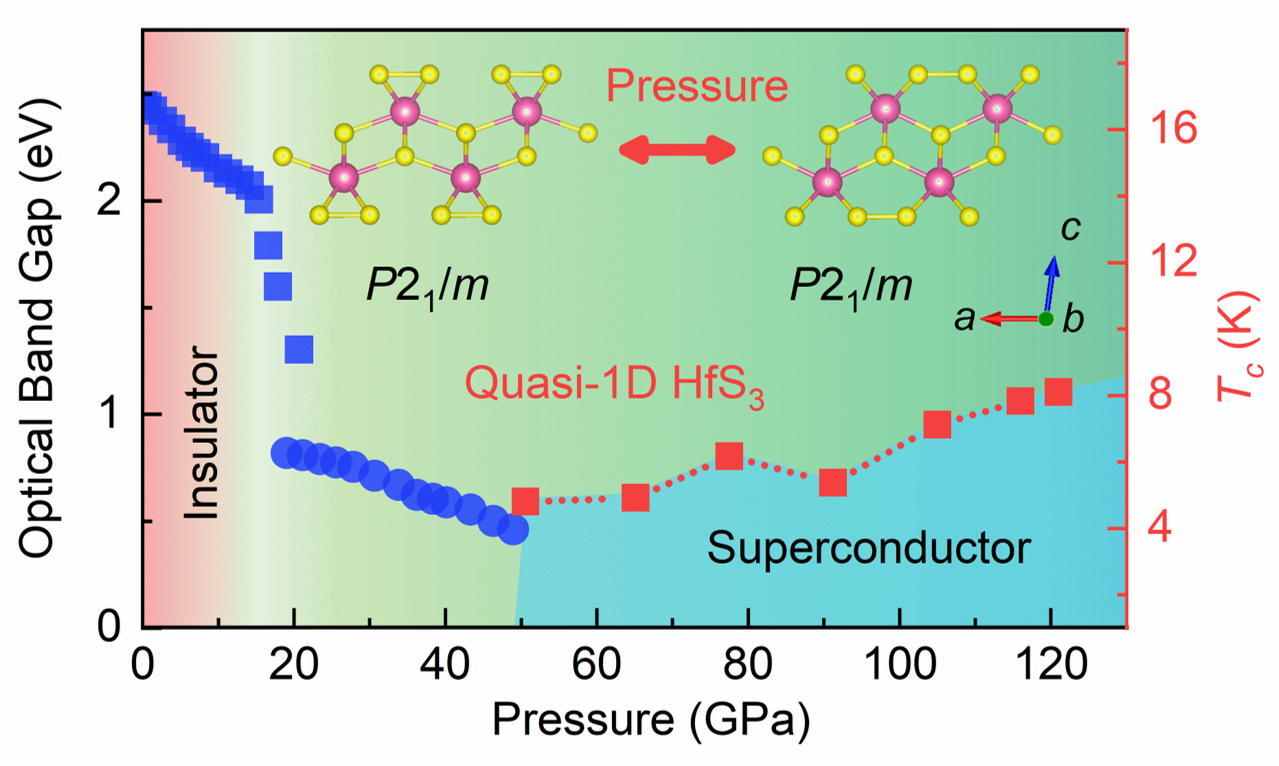Pressure induced superconductivity in quasi-one-dimensional HfS3 - Dr. Binbin Yue
JANUARY 5, 2023
Various transition metal trichalcogenides (TMTC) show unique electronic properties, such as metal-insulator transition, topological insulator, and even superconducting transition. Currently, almost all metallic TMTC compounds can show superconductivity either at ambient pressure or at high pressure. However, most TMTC compounds are semiconductors and even insulators. To find out if superconductivity could exist in non-metallic TMTC compound by artificial manipulation, researchers led by Dr. Binbin Yue from HPSTAR and Dr. Fang Hong from Institute of Physics studied the electronic behavior of highly insulating HfS3 and successfully observed the superconducting transition under high pressure. The results reveal that all TMTCs may be superconductors and open a new avenue to explore the abundant emergent phenomena in the TMTC material family. This work is published in the Journal of the American Chemical Society (DOI: 10.1021/jacs.2c11184).
Transition metal chalcogenides (TMCs) are types of layer-structured semiconductors or metals with great potential as the next generation of electronics and optoelectronics. As an important branch in this family, TMTCs show the characters of quasi-one-dimensional properties, unlike the well-studied transition metal dichalcogenides (TMDCs) in the form of a typical two-dimensional structure. According to the distinctive stacking sequences of the one-dimensional chain variants, TMTCs could show electronic properties vary from superconducting to semiconducting (even highly insulating) which allows their application in various areas. Previously, all reported TMTC materials with a superconducting transition are metallic at ambient pressure. For semiconducting TMTCs, which contain most members of this family, it is still an open question that whether superconductivity could be induced by artificial manipulation.
In this work, the electronic behavior of HfS3 has been manipulated in terms of pressure. Among all MX3 compounds, the band gap of HfS3 is almost the largest which makes it highly insulating. HfS3undergoes an insulator-to-semiconductor transition near 17 GPa with a band gap reduction of ~1 eV. Raman spectroscopy and x-ray diffraction measurements reveal an iso-symmetric phase transition at this pressure, suggesting the structural origin of the electronic transition. Upon further compression, HfS3 becomes a superconductor without further structural transition. The superconducting transition occurs as early as 50.6 GPa, and the Tc reaches 8.1 K at 121 GPa, which sets a new record for TMTCs.

Compared with widely-studied ZrTe3 and HfTe3, HfS3 shows a totally different superconducting behavior, with superconductivity appearing in the high-pressure phase and exhibiting a bulk-like feature. Meanwhile, pressure-induced superconductivity observed in other metallic MX3compounds are all claimed to be related to the CDW disappearing, while no clear CDW feature was observed in HfS3. Therefore, it could provide a possible opportunity to study the superconducting mechanism without CDW in the MX3 material family.
The superconducting transition is first achieved by pressure in such an originally insulating TMTC compound, which suggests that other semiconducting TMTC might also be promising superconductors under high pressure. It will expand the phase diagrams of MX3 to a much larger extent.
Caption:Proposed phase diagram of HfS3 based on electric measurements and optical absorption results.
作为过渡金属硫化物(TMC)家族中的重要成员,过渡金属三硫化物(TMTC)MX3因其独特的准一维结构表现出了一系列新颖的物理特性,如金属绝缘转变,拓扑绝缘体,超导转变等。目前,已经报道的具有超导转变的过渡金属三硫化物在常温常压下都是金属,而大部分MX3家族成员都是半导体甚至绝缘体。那么,在这些半导体/绝缘体型的过渡金属三硫化物中,是否也能够实现类似于金属型MX3化合物中所发生的超导转变?近期,北京高压科学研究中心的岳彬彬研究员与中科院物理所的洪芳研究员等合作,首次在绝缘体类MX3化合物中观测到了压力诱导的超导现象¾具有较大带隙的绝缘体型HfS3在压力作用下带隙逐渐缩小,当压力达到~51 GPa时出现超导转变。并且,其超导转变温度伴随压力的增大而升高,当压力达到~121 GPa时,可以升至8.1 K,为目前已报道的MX3化合物中最高的超导转变温度。该研究表明其他半导体/绝缘体型MX3化合物也是潜在的超导材料。相关工作发表在《美国化学会志》上。
